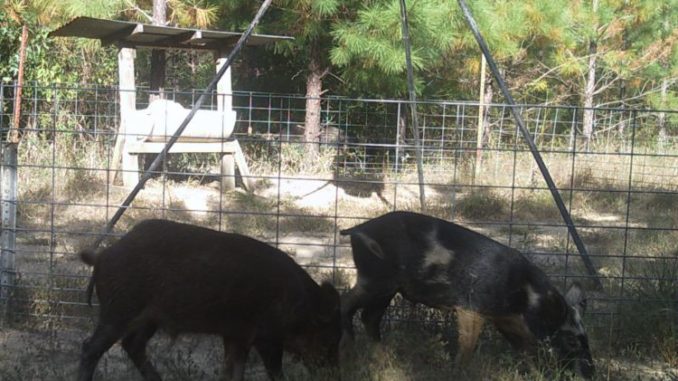
Poisoning hogs may be going too far too fast
Kaput is the brand name of a toxicant approved by the U.S. Environmental Protection Agency (EPA) for use as a lethal bait for feral hogs. According to the label, the active ingredient in Kaput is Warfarin, an anticoagulant medication sold under the brand name Coumadin. Not much information, I know, but enough for us to understand that Kaput kills when consumed by hogs AND wildlife.
As we all know, feral hogs have become a near nationwide problem. Here in Louisiana feral hogs damage agricultural areas, levees and wildlife habitat. They compete with native wildlife species for food and will even prey upon fawns, ground nesting birds and other wildlife. The problem has gotten worse in recent years due to explosive increases in feral hog populations.
Up until now feral hog control efforts have been focused on hunting (both for sport and extermination) and trapping. Feral hogs are listed as Outlaw Quadrupeds and may be taken by licensed hunters year-round during legal shooting hours. On private land, they may be taken at night during certain times of the year. Trapping hogs has also been effective and advances in trap technology have increased success.
There is no magic bullet, no one answer to feral hog problems. As is the case with many other nuisance animals, a number of methods must be employed to deal with the problem. And as in other cases, each method must be carefully considered before being implemented. The benefits must be weighed against the risks and possible harm to non-target animals and people. Such is the case with toxins.
Toxins, poisons and pesticides have been used illegally to kill hogs, coyotes and other so-called pests for years and LDWF’s Law Enforcement Division has investigated many such cases. In all of them a variety of animals were killed, some intentionally, some not. Unfortunately, not all of those cases were solved and the offenders often escape justice. It is a difficult case to make and many go unreported.

Like all other toxins, Kaput kills when a fatal amount is consumed. The Kaput instructional video directs removal of all livestock from the treatment area before use and for 90 days after removal. That is not an option for wildlife. The instructions also call for use of a feeder with an 8 pounds minimum weighted lid. It is doubtful whether this would block a raccoon from accessing the bait, let alone a bear. Bait scattered by feeding hogs would also be available to other wildlife species including deer.
Other requirements, according to the video, are mandatory site visits every one to four days, posting of signs warning of the presence of Kaput, proper disposal of carcasses and reporting the death of any non-target animals to state authorities. As an experienced law enforcement officer, I foresee a number of enforcement issues sure to arise, not the least of which is compliance with reporting the death of non-target animals. Another immediate problem would be the inability to trace or determine the location of the toxin killing non-target animals since we don’t know how far an affected animal may travel from the bait site.
Speaking of what we don’t know, the list is pretty lengthy. What about secondary toxicity which occurs when another animal feeds on the carcass of a hog killed by toxin? Biologists point out that no independent studies have been done to show the true mechanism of the product and there is zero information on what Kaput will do to deer. But it is known that a sub-fatal dosage will cause abortion, a serious effect on reproduction in deer.
Consider also the effect consumption of the meat of a low dosage hog or deer may have on humans. It is shown that a lethal dose causes obvious blue coloration in the meat and fat of the animal. But how much and how long it takes before low levels become obvious and dangerous in meat remain unclear.
The Association of Fish and Wildlife Agencies (AFWA), the Southeastern Association of Fish and Wildlife Agencies (SEAFWA) and LDWF have all submitted letters to the EPA expressing their concerns regarding Kaput.
Earlier this year Louisiana Agriculture and Forestry Commissioner Mike Strain registered (approved) Kaput for use in Louisiana. LDWF’s concerns regarding primary and secondary impacts to wildlife and the lack of information or studies regarding the toxin led to the introduction of House Bill 515 by Rep. Stuart Bishop (R-Lafayette) during the Regular Session of the Legislature. The bill required concurrent approval of any toxicant to control or kill feral hogs by both the Secretary of LDWF and the Commissioner of Agriculture based on scientific data. Commissioner Strain has unregistered Kaput for use in the state at this time and on May 2, HB 515 was voluntarily deferred in committee.
But this is far from over and I suspect efforts to register Kaput in Louisiana will begin again not long after the session ends. So far little has been heard from Louisiana’s hunters. If you share the concerns expressed by our wildlife professionals be sure and let your support be known. Your senator and representative, along with the Secretary of LDWF and the Wildlife and Fisheries Commission are good places to start.
Readers can contact State Representative Stuart J. Bishop with their comments at 337-981-7409 and bishops@legis.la.gov.
You can contact the LDWF to provide comment to the Secretary and Commission at 225-765-2800 or go to wlf.louisiana.gov and navigate to the Secretary’s office or public comments to the Commission to voice your concerns.


